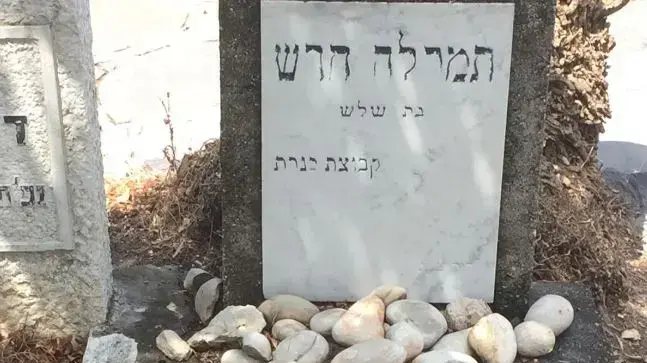- news
- News in Israel
- Events in Israel
BBQ at the entrance and destruction of gravestones: The vacationers in the Sea of Galilee are harming the historic cemetery
The halting of flights due to the corona has led to an increase in the number of visitors to the shores of the Sea of Galilee, which is felt in the nearby cemetery. Some set up sheds between the parking lot and the cemetery, lighting barbecues at the entrance and leaving behind mountains of garbage. Others smash parts of toddlers' graves. "It's hard to bear such a disparaging and hurtful attitude"
Tags- Kinneret
- cemeteries
- cemetery
Eli Ashkenazi
Sunday, 16 August 2020, 21:53The wave of visitors to the shores of the Sea of Galilee also left its mark on the Sea of Galilee cemetery - the kibbutz and the colony. Garbage mountains slide from the bins at the entrance gate to the cemetery, and the toilets also serve passers-by who come to bathe in the Sea of Galilee.
Einav Ben Yishai from Kibbutz Kinneret, who is in charge of maintaining the cemetery, said that people enter the toilet building and make makeshift showers inside it using the water taps. Alongside these, the most painful injury, she said, was the sight of displacing and smashing colored tiles imprinted on the gravestones of toddlers' graves.
The Kinneret Cemetery is considered an important historical site, and a few years ago it was even recognized as a national heritage site. The heads of the labor movement and socialist Zionism, including Berl Katzenelson, Dov Bar Borochov, Moshe Hess, Nachman Sirkin, as well as the poets Rachel and Naomi Shemer, are buried there.
More on Walla! NEWS
- A new settlement has been established in the Gilboa ridge, and may be the solution to polarization in Israeli society
- The struggle for the liberation of the Hasi River: Protesters protest the closure of access to the site
- Night of Falling Stars: An extra-large meteor shower was observed in the country's sky
- APPLIED TO GO: The button that can save your life
A member of the Sea of Galilee is also buried in the cemetery - Shaul Avigor (Meirov) - one of the fighters of Tel Hai and is laying the foundations for the intelligence services, as well as leading the illegal immigration project Aliya B. His son, Gur, who was killed in the War of Independence, is also buried there, along with many other soldiers.
In the same historic cemetery are also buried pioneers who drowned in Jordan or fishing in the Sea of Galilee, unknown people who were expelled from Tel Aviv by the Turks and died of diseases, a young man from the transit camp, pioneers who died in a fire Their lives come true.
More on Walla! NEWS
Where to fly and how to prepare before arriving at Ben Gurion Airport? Israel opens the sky
To the full article
The condition of a toddler from whom tiles were removed, Kinneret Cemetery (Photo: Einav Ben Yishai)Due to the importance of the cemetery and its proximity to a main road, tens of thousands of people visit it every year. The amounts of dirt have increased recently, but cases of vandalism have occurred in the past. Thus, for example, nine years ago an old military helmet was stolen and placed on the graves of the boys soldiers Dan Kinnerati and Gur Meirov who were killed in 1948. A concrete beam on which is written "The beloved and pleasant, in their lives and deaths have not parted," connects the two tombs and two old military helmets were placed on them with the deaths of the boys. One was stolen.
With the inclusion of the site in the heritage program, more than a million shekels were invested in the infrastructure and a parking lot, a toilet cubicle, paths and an orderly entrance were built, among other things. According to Ben Yishai, "improving the infrastructure is welcome, but it should be remembered that it also led to more people coming to the place today."
She claims that "because of the special situation this year, that people do not go on vacations abroad, many come simply to vacation, erecting shade sheds between the parking lot and the cemetery. They leave the rubbish and use the toilets. "
Ben Yishai also noted that the infrastructure that was trained was intended for cemetery visitors and not for vacationers, and in any case there are large garbage cans on site. But people throw the garbage in a small bin instead, and when it fills up - throw the garbage next to it.
The person in charge of maintaining and cleaning the toilets even had to wake up several times to people who entered the entrance plaza to the cemetery, lit fires in barbecues, roasted meat and smoked hookahs. In one case, they chose to do so next to "Dekel Rachel", which is attributed to the tree on which the poet Rachel wrote the words "Dekel Shefel Tzameret" in the poem "Kinneret" (the name of the Golan Heights). The palm was broken a year and a half ago in a winter storm and a new palm was planted in its place.
The Jordan Valley Regional Council finances the daily cleaning of the toilets, but all the maintenance expenses of the cemetery are financed by Kibbutz Kinneret and it is an annual expense of more than NIS 200,000. According to estimates made a few years ago, about 200,000 visitors come to the site every year.
"I cultivate the place with great love," Ben Yishai said. According to her, she insists on sowing and planting wild plants in Eretz Israel and avoids spraying with pesticides, and many birds began to arrive at the cemetery. "It is an extraordinary place in its importance and beauty, but it is difficult for me to bear the disparaging and hurtful attitude on the part of some people," she said.

